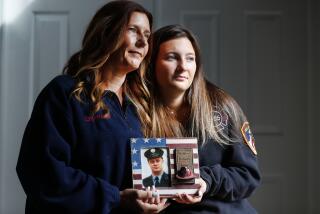Comic-book duo re-create unlikely story: 9/11
- Share via
Children’s comic-book veterans Sid Jacobson and Ernie Colon -- age 76 and 75, respectively -- seem a most unlikely duo to make it big in the graphic-book medium, a field dominated by manga, superheroes and the avant-garde. After toiling in near anonymity for more than 50 years, the longtime friends have burst into the media spotlight with their recently published graphic adaptation of “The 9/11 Commission Report.”
Released to coincide with the fifth anniversary of Sept. 11, “The 9/11 Report: A Graphic Adaptation” condenses the original 567-page report down to 131 comic-book pages. Reviews of the book have been mostly favorable, and the Chicago Tribune called it “unexpectedly moving.”
“I think the comic-book format has been wrongly stigmatized,” said Jacobson, who lives in Los Angeles. “This book shows just what can be done with the graphic medium, and just how successful that medium can be.”
So far, early sales are proving Jacobson’s point. The book boasted an initial print run of 60,000 copies, and has gone back for additional printings of 20,000. And like its original source material, which was published two years ago, the adaptation has made the New York Times bestseller list, debuting at No. 6 in the paperback nonfiction category.
For Jacobson and Colon, the recent spate of media attention is unprecedented. Since the early 1950s, when they first met at New York’s Harvey Comics, Jacobson and Colon are primarily known in comic-book circles for their work together on titles featuring Richie Rich (a character Jacobson co-created) and Casper the Friendly Ghost.
In addition to Richie Rich, Jacobson also helped create Hot Stuff, the Ghostly Trio and other characters that helped generate millions for Harvey. Jacobson, however, never saw a dime for his creations beyond his editor salary.
“Back then we were all considered work-for-hire, so creating characters was just part of the job,” says Jacobson, who moved from New York to Los Angeles in 1990.
Ironically, one of Jacobson’s biggest paydays is coming from a property that he had absolutely no hand in creating. As a work of the U.S. government, the 9/11 report falls in the public domain, a fact discovered by Colon when he read a news story about director Ron Howard’s effort to turn the report into a film.
“It was the beginning of 2005 when I read the story, and by coincidence I had also been trying to read the original report, but I couldn’t get beyond page 50 -- there were so many things to remember and so many Arabic names and places,” says Colon, speaking by phone from his Long Island, N.Y., studio. “So I thought to myself, ‘Sid and I could do the job of clarifying it,’ and when I called Sid up, he thought it was a great idea.”
After receiving initial backing from former Harvey CEO and Hollywood producer Roger Burlage, Jacobson dedicated the next four months to whittling down the dense report into digestible sound bites while Colon spent 16 months turning those words into pictures.
Given the nature of the book, , Jacobson and Colon bypassed comic-book publishers in favor of garnering a better deal with one of the major New York publishing houses. Their gamble paid off. According to Jacobson, they quickly received an offer from Hill and Wang, which was looking to start a line of graphic nonfiction titles.
Though this is not the first time Sept. 11 has been depicted by the comics medium. Art Spiegelman’s first-person account “In the Shadow of No Towers” is the most notable example. But some critics of the adaptation argue the medium is an inappropriate venue for such a sensitive topic.
In particular, they’ve taken umbrage with Colon’s use of “Blamm!” in big red letters in a panel showing American Airlines Flight 77 crashing into the Pentagon. “The sound effects seemed to have jarred some people, but we accept sound effects as being part of the language of movies,” Colon says. “Sound effects are also the language of my craft, and when I draw a building falling, I have to be able to show the sound that makes.”
Jacobson and Colon note that the chairman and vice-chairman of the 9/11 Commission, Thomas H. Kean and Lee H. Hamilton, put their stamp of approval on the adaptation by penning the foreword.
Hamilton, who currently serves as the president and director of the Woodrow Wilson International Center for Scholars, said he had reservations when he first heard about the adaptation. But after looking at the pages, he quickly came to the realization that it was professionally done and faithfully followed the report. “It also opens the report up to a whole new audience that doesn’t read much anymore.”
As a follow-up to the adaptation, Jacobson and Colon are ramping up for another graphic nonfiction book for Hill and Wang tentatively titled “After 9/11: A Graphic History of the War on Terror.”
“The book will be based on news reports, and we hope to have it done within the next year,” Jacobson said. “It’s the next step in what I like to call graphic journalism -- reporting with words and pictures.”
More to Read
The biggest entertainment stories
Get our big stories about Hollywood, film, television, music, arts, culture and more right in your inbox as soon as they publish.
You may occasionally receive promotional content from the Los Angeles Times.










